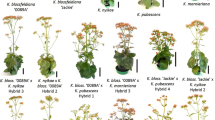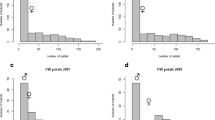Summary
The purpose of this study was to determine at what stage of seedling development the flowering attributes in winterhardy R. rugosa hybrids could be assessed and if these attributes could be improved through breeding. The analysis of flowering was based on the duration of the flowering period and on amount of flowers produced.
Most seedlings from rugosa hybrids could be assessed at an age of 3 years. The duration of the flowering period and flower productivity were not correlated. Several seedlings were improved in both attributes over the longer flowering and more floriferous parent.
Similar content being viewed by others
References
Hurst C. C., 1941. Notes on the origin and evolution of our garden roses. Jl. R. hort. Soc. 66: 73–82.
McFarland, 1969. Modern roses. 7. McFarland Company, Harrisburg, Penn., USA.
Semeniuk P., 1971. Inheritance of recurrent blooming in R. wichuraiana. J. Hered. 62: 203–204.
Svejda Felicitas J., 1971. Evaluation of shrub roses. Greenhouse-Garden-Grass 10(4): 65–72.
Author information
Authors and Affiliations
Rights and permissions
About this article
Cite this article
Svejda, F. Breeding for improvement of flowering attributes of winterhardy Rosa rugosa hybrids. Euphytica 26, 697–701 (1977). https://doi.org/10.1007/BF00021694
Received:
Issue Date:
DOI: https://doi.org/10.1007/BF00021694




